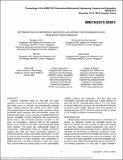| dc.contributor.author | Wei, Mengyao | |
| dc.contributor.author | Somasundaram, Sivanand | |
| dc.contributor.author | He, Bin | |
| dc.contributor.author | Liang, Qian | |
| dc.contributor.author | Raj, Rishi | |
| dc.contributor.author | Tan, Chuan Seng | |
| dc.contributor.author | Wang, Evelyn N. | |
| dc.date.accessioned | 2021-11-02T14:45:06Z | |
| dc.date.available | 2021-11-02T14:45:06Z | |
| dc.date.issued | 2015 | |
| dc.identifier.isbn | 978-0-7918-5750-2 | |
| dc.identifier.uri | https://hdl.handle.net/1721.1/137101 | |
| dc.description.abstract | © Copyright 2015 by ASME. Biporous evaporator wicks for heat pipe and vapor chambers can perform superiorly by reducing the viscous drag with larger pores or channels and simultaneously generate higher capillary pressure with smaller pores radius. Unlike conventional sintered metal biporous wicks, cylindrical silicon micropillar based evaporator with microchannels, possess the following advantages: mature and easily controllable fabrication process, possibility of direct integration with semiconductor devices and no risk of thermal expansion mismatch. In this work, we investigated a biporous wick for the evaporator design, which consists of micro pillar arrays interspersed within micro channels. This design was systematically studied by constructing a mathematical model, by coupling Brinkman's equation with mass and energy conservation equations, to predict the biporous wicks' heat transfer performance. In order to find the best combination of geometric factors that give the highest heat flux at a certain superheat value, optimization in Matlab was done. The effect of diameter to pitch ratio, aspect ratio, channel width and contact angle on wick's permeability, capillary pressure and evaporative heat flux were also investigated. Conclusion was drawn that a higher diameter to pitch ratio of 0.57, reasonable aspect ratio of 1.75∼3.22, island to channel width ratio of around 1.96 are preferred in this kind of biporous wick's design. Biporous wick show potential to dissipate heat flux of 515.7 W/cm2 at superheat of 40 °C, which is 134 % higher compared to monoporous wick. | en_US |
| dc.publisher | ASME International | en_US |
| dc.relation.isversionof | http://dx.doi.org/10.1115/IMECE2015-52651 | en_US |
| dc.rights | Article is made available in accordance with the publisher's policy and may be subject to US copyright law. Please refer to the publisher's site for terms of use. | en_US |
| dc.source | ASME | en_US |
| dc.title | Optimization of Biporous Micropillar Array for Enhanced Heat Transfer Performance | en_US |
| dc.type | Article | en_US |
| dc.identifier.citation | Wei, Mengyao, Sivanand Somasundaram, Bin He, Qian Liang, Rishi Raj, Chuan Seng Tan, and Evelyn N. Wang. “Optimization of Biporous Micropillar Array for Enhanced Heat Transfer Performance.” Volume 8B: Heat Transfer and Thermal Engineering (November 13, 2015). doi:10.1115/imece2015-52651. | en_US |
| dc.contributor.department | Singapore-MIT Alliance in Research and Technology (SMART) | |
| dc.contributor.department | Massachusetts Institute of Technology. Department of Mechanical Engineering | |
| dc.relation.journal | Volume 8B: Heat Transfer and Thermal Engineering | en_US |
| dc.eprint.version | Final published version | en_US |
| dc.type.uri | http://purl.org/eprint/type/ConferencePaper | en_US |
| eprint.status | http://purl.org/eprint/status/NonPeerReviewed | en_US |
| dc.date.updated | 2019-01-10T14:51:47Z | |
| dspace.orderedauthors | Wei, Mengyao; Somasundaram, Sivanand; He, Bin; Liang, Qian; Raj, Rishi; Tan, Chuan Seng; Wang, Evelyn N. | en_US |
| dspace.embargo.terms | N | en_US |
| dspace.date.submission | 2019-04-04T13:19:47Z | |
| mit.license | PUBLISHER_POLICY | en_US |
| mit.metadata.status | Authority Work and Publication Information Needed | en_US |
